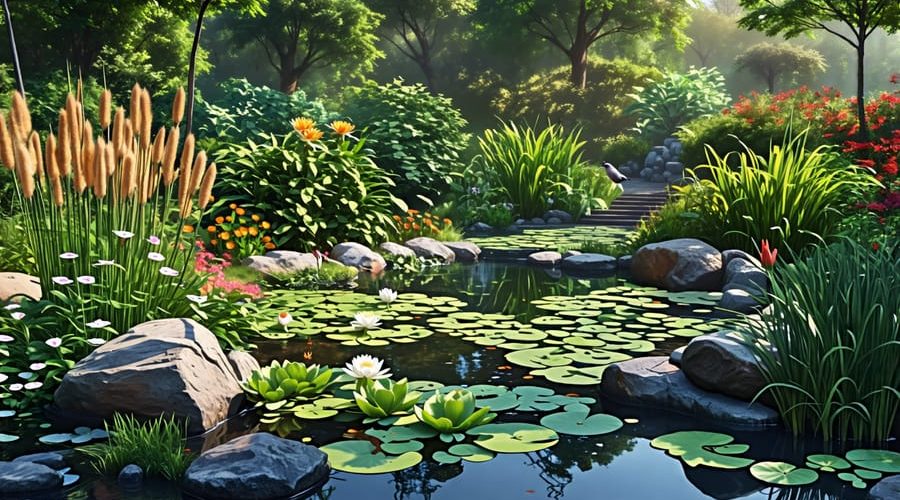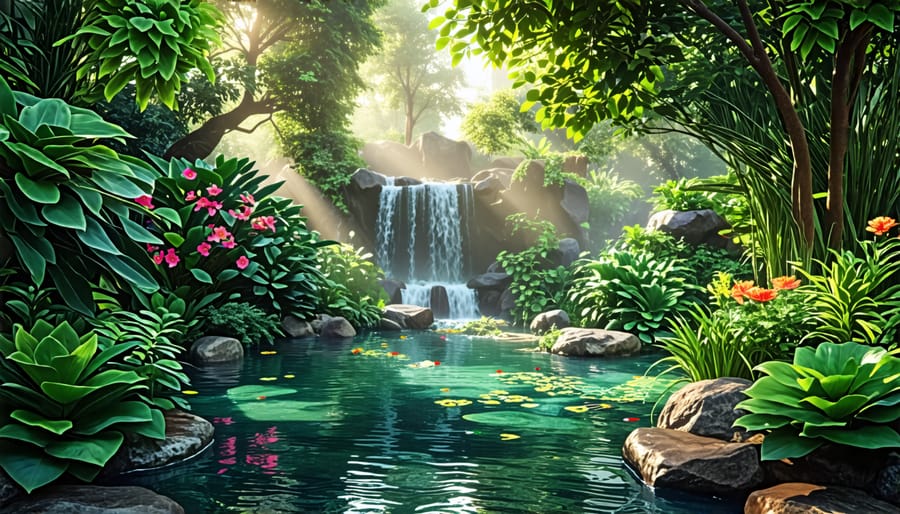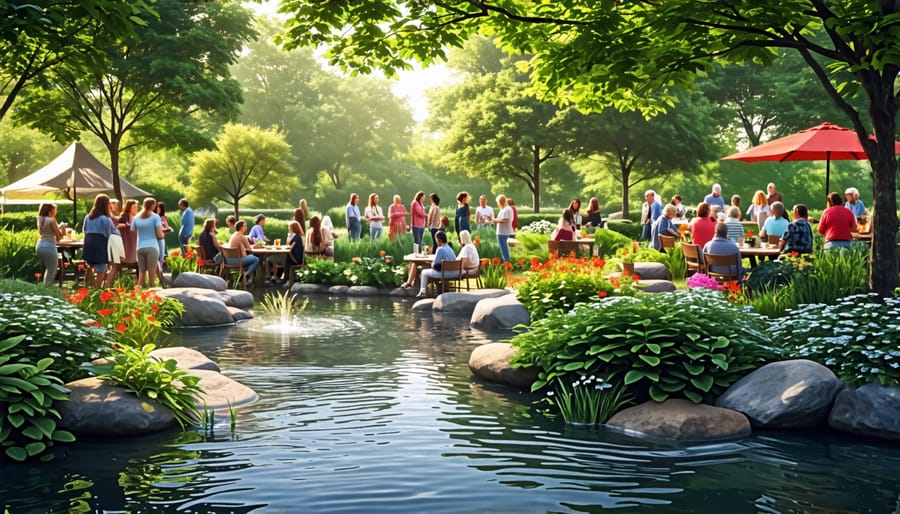
Transform Your Water Garden with These 7 Wildlife Conservation Pillars
Incorporate native plants and aquatic vegetation around your water garden to support local wildlife, offering food and habitat for insects and birds. Design diverse water features with varying depths and edges to attract different aquatic creatures and support their ecological needs. Install natural filtration systems like biological filters and aquatic plants to maintain clean water and a healthy environment for both plants and animals. Create basking spots using rocks and logs to provide reptiles and amphibians with a place to sun themselves, supporting their lifecycle needs.
1. Habitat Preservation
For many garden lovers, the backyard pond isn’t just an aesthetic focal point; it serves as a vital ecological haven. Preserving natural habitats within your water garden is crucial to supporting a diverse array of flora and fauna. By integrating habitat hacks, you can transform your pond into a flourishing ecosystem. Consider introducing native aquatic plants like water lilies and cattails, which provide shelter and food for local wildlife. Not only do these plants offer a natural beauty to your garden, but they also play a vital role in water filtration and maintaining healthy oxygen levels.
Encouraging biodiversity is more than just planting; it means creating an environment where various species can thrive. Incorporate different pond depths and shorelines to attract diverse creatures. Shallow edges are perfect for amphibians, while deeper sections appeal to fish and larger waterfowl. Additionally, adding rocks or logs can provide perches and basking spots for turtles and birds.
Remember, every small action contributes to the broader environmental impact. By nurturing your water garden with care and intention, you’ll be promoting wildlife conservation right in your backyard. This commitment to preserving natural habitats not only enriches the local ecosystem but also enhances your own connection to the natural world.

2. Pollution Reduction
Creating a pond or water garden not only enhances the beauty of your outdoor space but also sustains local wildlife, including various aquatic species. One of the critical aspects of maintaining a healthy pond environment is pollution reduction, which has a direct impact on water quality and the vitality of aquatic life. There are several effective methods to minimize pollution, ensuring your water garden remains a thriving habitat.
Start by ensuring your pond has proper filtration. Installing a biological filter will break down harmful substances, converting them into less toxic elements, while a mechanical filter will capture physical debris, keeping the water clear. Regularly cleaning these filters is crucial to maintaining their efficiency. Additionally, consider incorporating aquatic plants like water hyacinths and lilies, which act as natural filters by absorbing excess nutrients that can pollute the water.
Minimizing runoff into your pond reduces the risk of harmful chemicals entering the water. Create buffer zones of native plants around your pond to absorb potential pollutants. Use organic or less toxic alternatives for garden care to prevent chemical buildup.
Finally, avoid overstocking your pond with fish. Overcrowding can lead to an excess of waste, degrading water quality. By carefully managing your pond’s ecosystem, you ensure a healthy, balanced environment that supports vibrant aquatic life and brings joy to your garden’s visitors.

3. Sustainable Planting
Creating a water garden that thrives harmoniously with nature involves thoughtful plant selection and placement. Embracing sustainable planting means prioritizing native and non-invasive species to complement the local ecosystem. Native plants are adapted to the regional climate and soil, offering the dual benefits of effortless growth and critical support for wildlife. They can significantly enhance the biodiversity within your garden, attracting butterflies, birds, and beneficial insects.
Start by researching the native species in your area that thrive in aquatic environments. This might include vibrant water lilies or the delicate beauty of irises. Inviting such plants into your pond ensures the ecosystem remains balanced, as these plants fit seamlessly into the local environmental tapestry.
Pay special attention to avoiding invasive species, as they can quickly disrupt ecological harmony. Learn more about the battle against invasive plants to understand why choosing non-invasive options is crucial.
When planting, consider the plant’s growth habit and how it fits in with your overall design. Group plants with similar sun and water needs together for optimal health. Regularly monitor and maintain your garden, removing any new invasive threats at first sight. With each native plant you introduce, you’ll be fostering a self-sustaining pond environment teeming with life and beauty, encouraging a thriving habitat for all.
4. Responsible Water Management
Efficient water use in your pond not only supports the environment but also enhances the natural beauty of your outdoor space. Start by assessing your pond’s water needs. Install a rain-harvesting system that channels downspouts to your pond, utilizing nature’s gift for a sustainable refill source. A small pump driven by solar energy can help maintain water circulation, reducing stagnation and promoting healthier conditions for plants and fish. By implementing a plant filtration system, you can naturally purify the water. Consider adding native aquatic plants that thrive in your region; they help in filtering out nutrients that could lead to algae overgrowth while providing habitat for local wildlife.
Routine maintenance is essential. Skim debris off the surface with a net regularly and ensure that the pond doesn’t become overcrowded with fish. Overfeeding fish can degrade water quality, so keep an eye on their portion sizes. For more tips on keeping your pond pristine, explore these clear pond secrets.
Incorporating these responsible water management practices will not only foster an eco-friendly pond environment but also instill a sense of accomplishment and joy in maintaining a habitat that invites nature right to your backyard. By nurturing your pond thoughtfully, you’re making a positive impact on local wildlife and the wider ecosystem.
5. Supporting Local Wildlife
Creating a welcoming habitat for local wildlife is a rewarding way to enhance your water garden or pond. First, consider planting native vegetation around your pond. These plants provide shelter and food for a variety of species. For example, a cluster of native reeds and grasses can attract insects and birds while offering nesting sites. It’s also beneficial to incorporate a variety of plants to encourage biodiversity.
Adding bird feeders and nesting boxes nearby can entice local birds to visit. Choose seeds and plants that suit the diet of your area’s avian residents. Additionally, providing fresh water with a shallow edge, such as a bog area, can encourage creatures like frogs and beneficial insects to make your garden their home.
Consider adding floating plants, like lily pads, which offer frogs a spot to rest and insects a place to land. A log partially submerged in the water can serve as a basking spot for turtles and other creatures. Remember to avoid the use of pesticides and chemicals that can harm wildlife. With these simple steps, your garden can become a vibrant and dynamic ecosystem, teeming with life and enhancing your outdoor space in a sustainable, eco-friendly way.

6. Education and Community Engagement
Incorporating education and community engagement into your water gardening projects is a rewarding way to promote wildlife conservation right in your backyard. By sharing your knowledge about eco-friendly pond management, you can inspire others to transform their own spaces into thriving habitats. Hosting workshops or local gatherings provides a fantastic platform for exchanging ideas and best practices. You could discuss selecting native plants or demonstrate how to create natural filtration systems that benefit local wildlife.
Getting involved in community conservation initiatives amplifies individual efforts by contributing to larger ecological goals. Consider collaborating with local schools or environmental organizations to establish educational programs, or participate in community clean-up events. These activities not only enhance your understanding of ecosystem-friendly gardening techniques but also build a network of like-minded individuals. Engaging with your community in this way adds a fulfilling social dimension to your water gardening endeavor, making each step towards a sustainable ecosystem a shared victory.
7. Monitoring and Adaptation
Keeping a water garden thriving requires ongoing monitoring and adaptation. Observing your ecosystem regularly allows you to notice changes such as algae blooms, plant overgrowth, or shifts in water clarity. Early detection of issues can prevent more significant problems down the line. Pay attention to your plants and fish; they often provide the first hints of environmental stress. Seasons change, and so do the needs of your water garden. For instance, a sudden drop in temperature might mean adjusting fish feeding schedules or modifying plant care. Regularly testing water quality for pH levels and nitrates will help sustain a healthy habitat. Adapting your garden to incorporate more native plants can also improve resilience against pests and diseases. Using personalized checklists can keep tasks manageable, turning this upkeep into a joyful ritual. Grow with your garden, learn from each season, and witness how small adaptations bring your aquatic oasis to life!
Conclusion
As you reflect on the seven pillars of fostering wildlife-friendly water gardens, envision the ripple effect of these practices. Each step you’ve taken – from choosing native plants to providing essential habitats – contributes to a sustainable future where nature thrives alongside your creativity. By implementing these concepts, not only do you enhance the beauty of your garden, but you also play a crucial role in conserving biodiversity. Remember, every small change makes a big difference. Whether you’re a seasoned water gardener or just beginning your journey, there’s immense satisfaction in seeing your space transform into a vibrant, living ecosystem. So, embrace these guidelines as you design or refine your water garden. Share your success stories and inspire others in the community. Together, let’s create not just gardens, but sanctuaries that mirror the harmonious relationship between humans and nature, ensuring that future generations continue to enjoy the wonders of wildlife in their own backyard.
